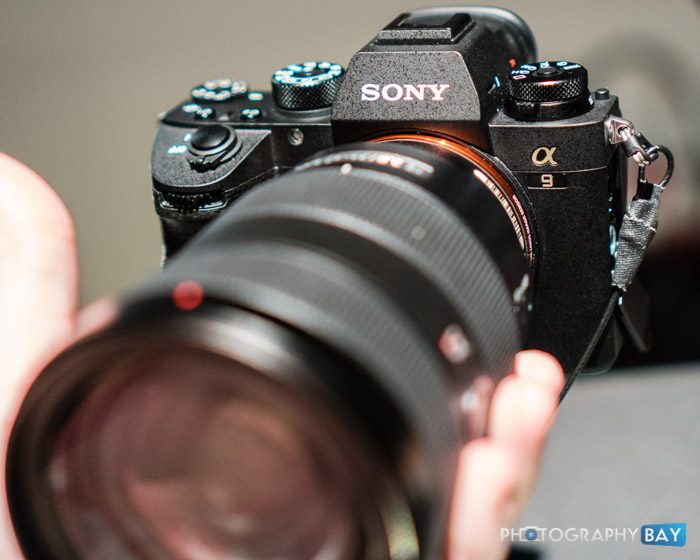
NAB 2017 is a very video-centric tradeshow. Today, however, I walked away with a striking impression of the photo industry. As the digital camera market becomes more and more niche, the benefit for manufacturers is that consumers in the market become more and more specific to the features and tech they want in their cameras.
As I sat in the Blackmagic Design press conference this morning, I was impressed with the company’s advances with Da Vinca Resolve 14, its new ATEM Television Studio Pro HD and Bluetooth features for the Ursa Mini Pro. However, the thing that struck me the most during the press event was the sheer number of Sony mirrorless camera users in the room. Not only that, but also the ratio of Sony mirrorless users to DSLR users.
While this is a bit of an anecdotal observation, we know that Sony just stepped into the second place position ahead of Nikon for the full-frame interchangeable lense camera sales in the US. Now, there are couple qualifiers there worth noting: (1) full frame and (2) US market. As I am now reviewing the Sony A6500, I can fairly say that Sony is on the right tech trajectory to overtake the APS-C market as well. When that will happen, I don’t know, but having used the A6500 for a few weeks, I can’t give you a good reason to buy a comparable DSLR over this camera.
As I was talking to my wife the other night, I told her something I had been chewing on for awhile now. I’m leaning toward moving away from Canon and going all-in with Sony. I’ve had nothing but Canon SLR/DSLRs as my primary kit since 2002. I bought a Sony A6000 a year or two ago and have been pleased with it but was still a few steps behind for me. Seeing the A7 models grow up and using several of them has been encouraging, but the A6500 and now, the A9, shows me that Sony has arrived.
I sat in a room full of practitioners today that create content with their cameras everyday and I saw more Sony mirrorless cameras than I saw DSLRs (not just Canon or Nikon, DSLRs in general). Sony is at critical mass, while Canon and Nikon continue to miss the boat. At least Canon is making an effort with its EOS M series but it may be too little too late unless the Rebel marketing machine makes some big changes over the next half-decade.
And it’s not like Canon hasn’t heard from its customers on the issue. Canon faithful and potential customers have been very outspoken about Canon’s conservative features throughout its camera lineup. While Canon may well have the best lens lineup in the market, it is all for naught if the company refuses to make a camera that delivers the goods like Sony’s A7 models.
I hear excuses about Canon’s conservative approach being tied to its Japanese roots. However, Sony is also a Japanese company and has no problem responding to what has become a rabid fanbase in delivering new and exciting camera models. Sure, Canon just announced it’s adding C-Log to the 5D Mark IV but that’s the cheapest 4K DSLR that it offers – and it costs $3500. Sony’s 4K mirrorless cameras start under $1000. Panasonic gets you there for less than $800 with the G7.
Frankly, I think Canon loves its brand so much and so is romantic about the Rebel brand that it is afraid to mess with the magic. The Rebel brand is nearly 27 years old. It’s been around almost since the EOS system launched 30 years ago. The Rebel brand is everything to the EOS system and those regular refreshes of the Canon Rebel DSLRs keep the cash cow flowing. Everyone (EVERYONE) knows what a Canon Rebel is. It is THE entry-level DSLR.
But its days are numbered.
Maybe 5 years. Maybe 10 years. But Canon will either change the Rebel brand to mean something other than “entry-level DSLR” or someone else (like Sony) will create the next “Rebel” brand. The kicker to it is that the ball is in Canon’s court.
Canon has had the power to dominate the camera niche for the next 40 years but it has squandered the past decade by playing defense instead of offense. (Before you say “5D Mark II,” read up on the happy accident that it was. It became much more than anticipated because Canon didn’t quite know what it had before it launched.) And now, we’re seeing Sony play such aggressive offense that Canon can’t continue to out-market Sony and dominate over the next two or three decades.
Don’t get me wrong, Canon makes great products and I’ve loved every Canon camera I’ve owned for the past 15 years. The market has changed drastically since 2007-10 and consumers have voted in the marketplace with their wallets. And the market is the true equalizer.
Canon doesn’t act like it is worried about Sony. It should.
Copyright/DMCA Notice: The RSS entry was originally published on Photography Bay. RSSID#794326